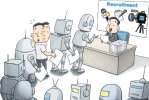1. When and why you are burying the time capsule
2. An explanation of your choice of items:
Choose at least one item for each category A-C below:
A Culture (music, literature, etc.)
B Technology
C Home life
3. One or two problems the world is facing today
Dear future friends,
My name is Li Hua._________________________________
Yours,
Li Hua

News anchors(主播) must have been reluctant to read out the following news: Xin Xiaomeng began working as the world’s first female artificial(人工的) intelligence news anchor at Xinhua News Agency on Sunday, three months after a male robot joined the profession.
Unlike previous news robots though, Xin does not read news like a cold machine; she reads it almost like a human being. The muscles on her face stretch and relax-and her reactions change-as she continues reading. That’s why many news anchors were worried: Will AI replace us in the near future?
To find the answer, we have to analyse the technologies that support Xin at her job. Three key technologies are used to support Xin. First, samples of human voices are collected and synthesized (合成). This is followed by the collection and synthesis of human muscle movement samples. And third the voices and movements are married in a way that when the Al news anchor reads, the micro -electric motors behind her face move to make her expressions seem more human.
Yet we need a thorough knowledge of deep leaning technology to make a robot imitate a person’s voice. The developer needs to collect tens of thousands of pieces of pronunciations, input them Into the machine and match them with the text or the Al to lean and read. The process for imitating facial movements is similar. The developer has to analyse the movements of the 53 muscles in the human face, make a model set from the collected data for the AI news anchor to lean, and imitate the movements of facial muscles via programs
Both the technologies used to make Xin’s performance impressive are mature. The real difficulty lies in the third -the technology to match the pronunciations with facial movements so that Xin expressions vary according to the content of the news report. In fact, Xins expressions don' t always change according to the content. As a result, her expressions look anything but human. Actually. AI is still no match for human qualities.
1. What does the underlined word "reluctant "in the first paragraph mean?| A.Delighted. | B.Unwilling. | C.Confused. | D.Optimistic. |
| A.They read news without expressions. | B.They looked like a human being |
| C.They could interview sports stars | D.They could interact with audience. |
| A.This technology is very perfect so far |
| B.This technology is quite popular now |
| C.This technology remains at the theoretical stage |
| D.This technology is far from mature. |
| A.human news anchors should learn from AT anchors to save their jobs |
| B.Al anchors perform much better than human news anchors at present |
| C.Al news anchors won 't replace human news anchors in the near future |
| D.Xin Xiaomeng s expressions vary so naturally that they are true to life |
3 . In 2015, a man named Nigel Richards memorized 386, 000 words in the entire French Scrabble Dictionary in just nine weeks. However, he does not speak French. Richards’ impressive feat is a useful example to show how artificial intelligence works — real AI. Both of Richard and AI take in massive amounts of data to achieve goals with unlimited memory and superman accuracy in a certain field.
The potential applications for AI are extremely exciting. Because AI can outperform humans at routine tasks — provided the task is in one field with a lot of data — it is technically capable of replacing hundreds of millions of white and blue collar jobs in the next 15 years or so.
But not every job will be replaced by AI. In fact, four types of jobs are not at risk at all. First, there are creative jobs. AI needs to be given a goal to optimize. It cannot invent, like scientists, novelists and artists can. Second, the complex, strategic jobs — executives, diplomats, economists — go well beyond the AI limitation of single-field and Big Data. Then there are the as-yet-unknown jobs that will be created by AI.
Are you worried that these three types of jobs won’t employ as many people as AI will replace? Not to worry, as the fourth type is much larger: jobs where emotions are needed, such as teachers, nannies and doctors. These jobs require compassion, trust and sympathy — which AI does not have. And even if AI tried to fake it, nobody would want a robot telling them they have cancer, or a robot to babysit their children.
So there will still be jobs in the age of AI. The key then must be retraining the workforce so people can do them. This must be the responsibility not just of the government, which can provide funds, but also of corporations and those who benefit most.
1. What is the main purpose of paragraph 1?| A.To introduce the topic. |
| B.To mention Nigel’s feat. |
| C.To stress the importance of good memory. |
| D.To suggest humans go beyond AI in memory. |
| A.Be superior to | B.Be equal to |
| C.Be similar to | D.Be related to |
| A.The writer. | B.The shop assistant. |
| C.The babysitter. | D.The psychologist. |
| A.Limit the application of AI to a certain degree. |
| B.Get more support from the government. |
| C.Apply for the donation from companies. |
| D.Upgrade themselves all the time. |



